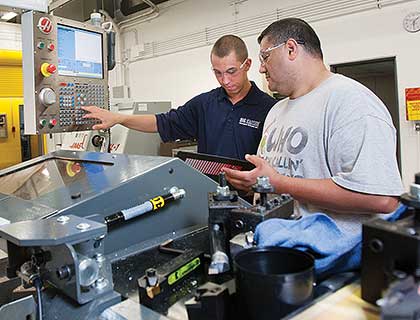PLEASE NOTE: The INAM Consortium was funded by a $12.9 million grant from the Department of Labor and tasked with delivering certificate programs in Advanced Manufacturing that can be completed in one year or less and prepare participants for employment in high-wage, high-skill occupations. While the INAM grant project has ended, these training programs remain vibrant at the individual Community Colleges. Please visit the colleges for ongoing program information.
At the successful completion of this certificate, the student was able to:
- Identify different careers available in the Industrial Maintenance field.
- Describe physical properties of a variety of equipment used in the workplace including: force, torque, simple machine, and mechanical drives.
- Utilize effective, safety-enhancing workplace practices in multiple sites.
- Demonstrate an understanding of safe and proper use of tools/supplies required to diagnose/repair a malfunction in the workplace.
- Employ a systematic approach to troubleshooting a scenario based upon an industrial equipment system failure/problem/complaint and prepare an effective repair solution.
- Interpret basic fundamental of blueprints mechanical drawings, designs, sketches, layout drawings, plans, specifications, shop drawings, service and repair manuals, and schematics used in industrial maintenance.
- Demonstrate the fundamentals of industrial fluid power which includes pneumatics and hydraulics, and electrical theory.
- Identify and demonstrate proper use of different types of basic electrical testing equipment.
- Understand how electricity is produced and the physics behind it such as voltage, amperage, resistance, and power.
This workforce solution was funded by a grant awarded by the U.S. Department of Labor’s Employment and Training Administration. The solution was created by the grantee and does not necessarily reflect the official position of the U.S. Department of Labor. The Department of Labor made no guarantees, warranties, or assurances of any kind, express or implied, with respect to such information, including any information on linked sites and including, but not limited to, accuracy of the information or its completeness, timelines, usefulness, adequacy, continued availability, or ownership. This solution was copyrighted by the institution that created it. Internal use, by an organization and/or personal use by an individual for non-commercial purposes, is permissible. All other uses require the prior authorization of the copyright holder.
Colleges Offering Certificates in this Career-
Illinois Eastern Community College - Wabash Valley CampusIndustrial Maintenance Certificate5 Courses (16 Credit Hours)
-
MechanicsINM1200 (4 Credit Hours)
-
Introduction to Industrial Maintenance TechINM1206 (2 Credit Hours)
-
Electro-Mechanics IINM2200 (5 Credit Hours)
-
Occupational Safety (OSHA)INM2210 (2 Credit Hours)
-
Math General Elective(3 Credit Hours)
-
-
Illinois Valley Community CollegeIndustrial Maintenance Certificate10 Courses (25-25.5 Credit Hours)
-
Basic Industrial Electricity IELE1200 (4 Credit Hours)
-
Equipment MaintenanceIMT1200 (3 Credit Hours)
-
Industrial SafetyIMT1208 (0.5 Credit Hours)
-
Industrial PneumaticsIMT1206 (2 Credit Hours)
-
PipefittingIMT1207 (2 Credit Hours)
-
Technical Mathematics IMTH1206 (3 Credit Hours)
-
Machine Blueprint ReadingDFT1203 (3 Credit Hours)
-
Motors and Controls IELE1202 (2.5 Credit Hours)
-
Or
-
Programmable Logic Controllers IELE1204 (3 Credit Hours)
-
Industrial HydraulicsIMT1205 (3 Credit Hours)
-
Stick, Plate, Flat ARC WeldingWLD1200 (2 Credit Hours)
-
-
John Wood Community CollegeIndustrial Maintenance Technician Certificate12 Courses (31 Credit Hours)
-
Intro to Manufacturing and Safety(MSSC-M1)MFG102 (2 Credit Hours)
-
Manufacturing Processes(MSSC-M3)MFG101 (2 Credit Hours)
-
Quality/Continuous Improvement(MSSC-M2)MFG104 (3 Credit Hours)
-
Introduction to ElectricityELE110 (3 Credit Hours)
-
Blueprint Reading for ElectricianELE101 (3 Credit Hours)
-
Blazing your TrailFYE101 (1 Credit Hours)
-
Intor to Manufacturing Maintenance(MSSC-M4)MFG103 (2 Credit Hours)
-
Technical MathMAT100 (3 Credit Hours)
-
Industrial WeldingWLD120 (3 Credit Hours)
-
Electrical Application IELE125 (3 Credit Hours)
-
Electrical Motors and ControlELE215 (3 Credit Hours)
-
Industrial Maintenance FundamentalsMFG114 (3 Credit Hours)
-
-
Joliet Junior CollegeIndustrial Maintenance Certificate of Completion7 Courses (19 Credit Hours)
-
Basic Wiring and Circuit DesignEEAS101 (4 Credit Hours)
-
Industrial Maintenance FundamentalsIMT101 (3 Credit Hours)
-
Industrial Fluid PowerIMT121 (3 Credit Hours)
-
Mechanical Power TransmissionIMT111 (3 Credit Hours)
-
Rotating EquipmentIMT112 (3 Credit Hours)
-
Beginning ARC WeldingWELD114 (1.5 Credit Hours)
-
ARC Welding IIWELD115 (1.5 Credit Hours)
-
-
Kankakee Community CollegeBasic Manufacturing Industrial Maintenance4 Courses (13 Credit Hours)
-
Fundamentals of ElectricityELTR 1064 (4 Credit Hours)
-
Basic WeldingWELD 1114 (4 Credit Hours)
-
Machine Tool IMCHN 1214 (4 Credit Hours)
-
Precision MeasurementMCHN 1311 (1 Credit Hours)
-
-
Oakton Community CollegeManufacturing Technology Cert (Maintenance)10 Courses (32 Credit Hours)
-
Basic AutoCADCAD116 (3 Credit Hours)
-
Introduction to Computer Information SystemsCIS101 (3 Credit Hours)
-
or
-
Computer Software and ConceptsCIS103 (4 Credit Hours)
-
Intermediate AlgebraMAT110 (4 Credit Hours)
-
or
-
Applied Mathematics IMAT114
-
Hydraulics, Pneumatics and ControlsMFG135 (3 Credit Hours)
-
Introduction to Robotics and Vision SystemsMFG140 (3 Credit Hours)
-
MASTERCAM Computer Aided ManufacturingMFG165 (4 Credit Hours)
-
Programmable Controllers (PLC)MFG240 (4 Credit Hours)
-
Applied PhysicsPHY101 (4 Credit Hours)
-
Introduction to Electricity and Automation ControlsAHR104 (4 Credit Hours)
-
Or
-
Introduction to ElectronicsELT101 (5 Credit Hours)
-
Or
-
Advanced PLC/Automation ApplicationsMFG250 (4 Credit Hours)
-
-
South Suburban Community CollegeMaintenance Technology I Certificate6 Courses (17 Credit Hours)
-
Industrial SafetyMFG121 (2 Credit Hours Credit Hours)
-
Industrial Blue Print Reading IMFG122 (2 Credit Hours Credit Hours)
-
Mechanical Drives IMFG123 (4 Credit Hours Credit Hours)
-
Electricity and MotorsMFG124 (4 Credit Hours Credit Hours)
-
Manufacturing MathMFG102 (2 Credit Hours Credit Hours)
-
Computer Literacy SkillsMIS101 (3 Credit Hours Credit Hours)
-



